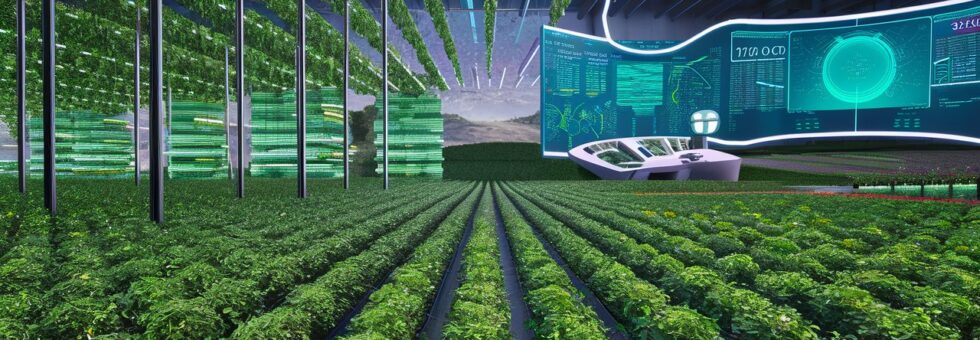As a farmer, you know that the future of agriculture lies in innovation. With a growing world population and increasing concerns about sustainability, new technologies and practices are needed to increase yields, reduce waste, and protect the environment. In this article, you will learn about some of the most promising innovations that are shaping the future of farming. From precision agriculture to vertical farming, scientists and entrepreneurs are finding creative solutions to grow more food using fewer resources. The adoption of these cutting-edge techniques has the potential to revolutionize the way you cultivate crops and raise livestock. By embracing innovation, you can help ensure that Agriculture remains productive and sustainable for generations to come.
Embracing Technology: How Farmers Are Using Al and Robots
Farmers today have access to advanced technologies like artificial intelligence and robotics that are transforming agriculture. Automated machinery is taking over tedious and labor-intensive tasks. Robotic systems can plant and harvest crops more efficiently than human laborers. Al-enabled sensors and drones provide real-time data on crop and soil conditions to support precision farming.
These technologies boost productivity and economic gains. A single farmer in a technologically advanced operation can oversee thousands of acres, compared to just a a few hundred acres using traditional methods. Increased automation also makes farming less physically demanding and more appealing to younger generations.
However, these technologies require significant capital investments and technical skills that may be a barrier for some farmers. There are also concerns about job losses, though new types of jobs are emerging in software and data analysis. Policymakers and companies should consider programs to provide farmers access to new technologies and retraining for workers.
Farmers who adopt advanced technologies will be poised to meet the challenges of the future, including population growth, climate change, and resource scarcity. Precision farming techniques can reduce environmental damage through targeted use of water, fertilizer, and pesticides. Robots and Al may eventually help develop new crop varieties more quickly.
Sustainable Farming Practices for a Greener Future
- Organic Farming
Organic farming avoids using synthetic fertilizers and pesticides, implementing natural techniques instead. This eco-friendly method improves soil health, produces high-quality crops, and sustains agricultural productivity long-term. Although organic production typically yields less, the premium prices often offset costs. Many farmers are transitioning to organic practices to meet consumer demand and gain a competitive advantage.
2. Crop Rotation
Crop rotation involves alternating the crops grown on a field to improve soil nutrition and structure. Farmers plant legumes, which add nitrogen to the soil, followed by crops that require nitrogen, such as corn or wheat. This technique helps reduce erosion, prevents disease buildup, and avoids depleting nutrients. Many large-scale farms have implemented multi-year rotation plans to improve land management.
3. Cover Crops
Cover crops provide soil coverage when fields are not in production. They prevent erosion, fix nitrogen, improve soil tilth, and naturally control weeds. Popular cover crops include rye, oats, beans, and clover. Although they require resources to establish, the long-term benefits to soil health and the reduced need for fertilizers make cover crops a worthwhile investment for sustainable farms.
4. Precision Agriculture
Technology like GPS, GIS mapping, and sensor systems allow farmers to precisely monitor crop conditions. Precision agriculture helps farmers apply irrigation, fertilizers, and pesticides only where needed and in appropriate amounts. This targeted approach reduces environmental impact and cuts costs while optimizing crop yields. As technology advances, precision techniques will become more accessible to farms of all sizes.
Sustainable farming practices benefit both the environment and farmers’ bottom lines. By protecting natural resources and embracing technology and innovation, agriculture can thrive economically while ensuring healthy, productive land for future generations. Focusing on long-term sustainability and responsible land management will be key to meeting the world’s growing food demands.
Vertical Farming: Growing Crops in Urban Environments
Vertical farming is an agricultural technique aimed at maximizing crop yields in a small area by growing produce in stacked layers. This method allows farmers to grow more crops in less space and in a controlled environment.
Controlled Environment Agriculture
Vertical farms are located in controlled indoor environments where all factors like light, humidity, and temperature can be regulated. Artificial lighting provides the full spectrum of light needed for photosynthesis. Temperature and humidity controls eliminate the impact of weather events and climate change. This predictable environment results in year-round crop production with higher yields.
Limited Space
As populations become increasingly urbanized, vertical farming provides a solution for growing more food in limited city spaces. By stacking layers of plants above one another, farmers can increase production on a small footprint of land. Plants are grown on vertically-inclined surfaces, such as walls or in stacked shelves. Automated systems are used to deliver water and nutrients to the plants.
Improved Yields
The controlled environment of vertical farms allows for improved crop yields. Conditions are optimized for plant growth, and pests, diseases, and weed pressure are eliminated. Multiple crop cycles can be grown in a year, increasing total annual production. Studies show that vertical farming can produce crop yields up to 20 times greater than traditional farming.
Vertical farming is an innovative solution that allows city dwellers to have locally-grown produce and support food security for future generations. By making the most of limited space and resources, vertical farming aims to meet the food demands of an increasing global population in an eco-friendly manner.
Regenerative Agriculture: Improving Soil Health and Biodiversity
Enhancing Soil Fertility
Regenerative agriculture aims to enhance soil fertility and health through techniques like crop rotation, cover cropping, and reduced tillage. Farmers plant diverse crops in rotation, including nitrogen-fixing legumes, to naturally fertilize the soil. They also plant cover crops, like buckwheat or rye, between cash crop seasons to prevent erosion, improve soil
structure, and increase organic matter. Reduced or no-tillage avoids disrupting the soil and its inhabitants. These methods work together to build soil organic matter, foster microbial life, and make nutrients readily available to plants.
Promoting Biodiversity
Regenerative agriculture promotes biodiversity above and below ground. Diverse crop rotations and cover cropping provide habitat and food sources for wildlife like birds, pollinators, and beneficial insects. They also feed the soil food web, including fungi, bacteria, protozoa, and nematodes. A single teaspoon of healthy soil can contain billions of microbes. These organisms are critical for decomposing organic matter, cycling nutrients, and supporting plant health.
Mitigating Environmental Impact
Regenerative techniques mitigate the environmental impact of industrial agriculture. They reduce pollution from fertilizers and pesticides, increase carbon sequestration in the soil, and curb erosion. Building soil organic matter is key. For every 1% increase in soil organic matter, the soil can hold an additional 20,000 gallons of water per acre. This improves resilience to droughts and floods. Healthy, living soil also absorbs more carbon dioxide from the atmosphere, helping to mitigate climate change.
Regenerative agriculture is a promising approach for creating sustainable food systems, as it regenerates the foundation of agriculture-the soil. By improving soil health, it enhances productivity, resilience, and environmental stewardship. Widespread adoption of regenerative techniques could transform agriculture into a solution for both food security and climate change.
Making Farming More Profitable With Data Analytics and loT
The agricultural industry is increasingly turning to data analytics and Internet of Things (IoT) technologies to optimize operations and maximize profits. Data Analytics By analyzing data from sensors, satellites, and other connected equipment, farmers gain valuable insights into variables affecting crop yields and livestock health. Predictive analytics can forecast the outcomes of various scenarios to help farmers make data-driven decisions. For example, analyzing soil sensor data and weather patterns allows farmers to determine the optimal amount of water, fertilizer, and pesticides for their crops.
Connected Farm Equipment
Tractors, irrigation systems, and other equipment are being connected to the loT, allowing for precision control and monitoring. Connected equipment can autonomously adjust application rates based on sensor data to precisely deliver resources. Farmers can remotely monitor equipment to check fuel levels, detect malfunctions, and track vehicle locations O optimize workloads.
Optimizing Resource Usage
By leveraging data analytics and loT technologies, farmers can gain a holistic view of operations to identify inefficiencies and waste. Analyzing water usage data from soil moisture sensors and weather stations helps farmers determine the minimum amount of water necessary for their crops. Monitoring utility usage in barns, processing plants, and equipment helps identify energy waste and opportunities for improvement. Reducing resource usage not only benefits the environment but also significantly cuts costs for farmers.
While the initial investment in data analytics and loT technologies may be high, the long Term benefits to profitability and sustainability make a compelling case for adoption. By optimizing resource usage, improving crop and livestock management, increasing equipment utilization, and streamlining operations, farmers can gain a competitive advantage and safeguard the future of their farms. New technologies are empowering farmers with the insights and control they need to maximize yields in an eco-friendly and cost-effective manner.
Conclusion
As we have seen, the future of agriculture is filled with exciting innovations that have the potential to transform farming as we know it. From hi-tech greenhouses to automated equipment, technology is enabling farmers to increase yields and efficiency. At the same
time, new farming techniques like hydroponics and vertical farming allow crops to be grown in urban areas, providing fresh produce while reducing transportation costs and emissions. While implementing these innovations requires investment, the long-term benefits for farmers, consumers, and the environment make them well worth pursuing. The key will be striking the right balance between technology and sustainability. If done thoughtfully, innovations in agriculture can usher in a new era of productive, eco-friendly farming that will help feed the world’s growing population.



1 Comment
saraikymunda84@gmail.com
April 2, 2024 - 9:18 pmNyc